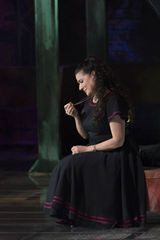| Opera Reviews | 19 April 2024 |
Bittersweet memoriesby Silvia Luraghi |
|
| Bernstein: West Side Story Salzburg Festival 25 August 2016 |
|
|
In June this year she planned a production of Leonard Bernstein’s musical West Side Story, an unconventional choice for a festival that focuses on classical music and opera, but a great success, which has also been planned for a run of long sold out performances at the Summer Festival. Bartoli is Maria, in a role which has been tailored to fit her by stage director Philip Wm. McKinley. She is already on stage before the music begins, in a prologue that the director has created in order to show what Maria is doing twenty years after Tony’s death - she’s still working in the tailor shop, and when the working day is finished sets out to walk home in the neighborhood in which two decades before she found and lost the love of her life. In the street, she thinks and remembers. And there starts the music, with Bartoli on stage for the whole of the performance, among the memories of her youth. She is doubled by another, younger Maria, Michelle Veintimilla, who takes part in the action and the dialogue but does not sing - all the singing belongs to the older Maria’s memories, and is accordingly performed by Bartoli. This looks a little awkward during the duets, but in general it works and is compelling. Bartoli’s operatic voice is somewhat too heavy for musicals, and the vibrato may at moments sound inappropriate, but she sings with delicacy and tenderness, and the applause that met her rendition of Somewhere was fully deserved. As Tony, tenor Norman Reinhardt sounded more at ease with the lighter singing style and showcased his excellent vocal skills in the aria Maria. All other singers had a background in musicals and were great performers, especially Karen Olivo, ideally cast as Anita. The Felsenreitschule offers a natural stage which looked very appropriate for representing the streets of Manhattan’s West Side. The stage was further divided in two levels by set designer George Tsypin, showing the tailor shop and Maria’s home on the upper level, and the streets and Don’s store on the lower one. Much was achieved through the contribution of choreographer Liam Steel with assistant Alois Glaßner, who put special care in giving life and energy to each scene. Conductor Gustavo Dudamel led the Simon Bolivar Symphony Orchestra with enthusiasm. In the end, melancholy turns to tragedy when the older Maria, after the recollection of her youth, puts an end to her life by jumping under a subway train.
|
|
| Text ©
Silvia Luraghi Photo © Salzburger Festspiele / Silvia Lelli |

 Cecilia Bartoli is at home in Salzburg; she has frequently been invited to sing at the Summer Festival over the years, and since 2012 has been artistic director of the Whitsun Festival.
Cecilia Bartoli is at home in Salzburg; she has frequently been invited to sing at the Summer Festival over the years, and since 2012 has been artistic director of the Whitsun Festival. 





